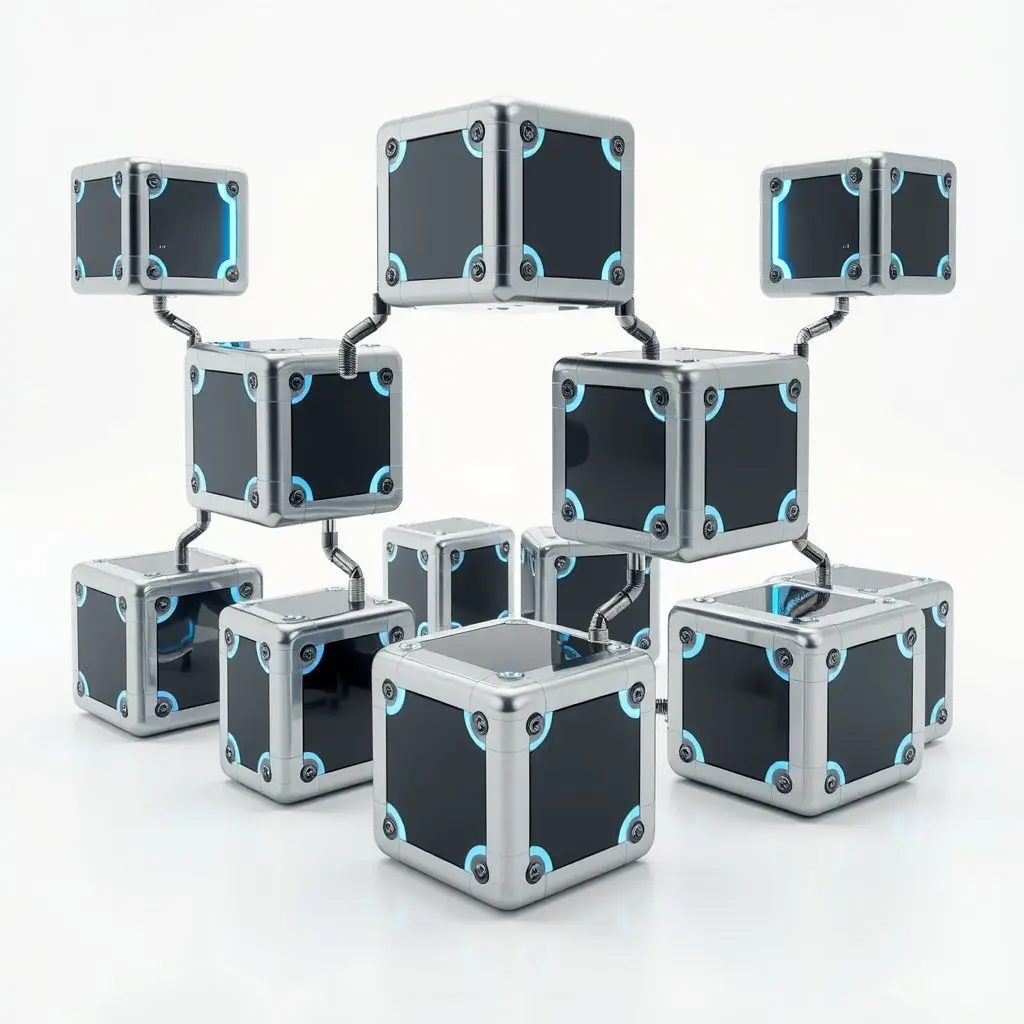Ever looked at the materials around you – the rigid steel of a building, the solid wood of a table, the unyielding glass of a window – and wished they could just… *change*? What if matter wasn’t so fixed, so permanent in its form? Prepare to have your perspective shifted, because the lines between the digital world of software and the physical world of atoms are beginning to blur, giving rise to something truly revolutionary: Programmable Matter.
This isn’t just a concept pulled from the pages of science fiction anymore. It’s a tangible area of research and development that envisions a future where materials don’t just exist; they respond, adapt, and transform based on your command.
Before we dive deep into this mind-bending concept, take a moment to catch our quick take on Programmable Matter in this YouTube Shorts video:
Pretty wild, right? Let’s unpack what this fascinating field is all about.
Table of Contents
What Exactly is Programmable Matter?
At its core, programmable matter refers to any substance or material that can be instructed to change its physical properties, such as shape, density, conductivity, optical qualities, or even color, in a predictable and controllable manner. Think of it less like traditional, static materials and more like matter that behaves like software – capable of executing commands and altering its state accordingly.
The underlying principle often involves creating materials from vast numbers of tiny, interacting components – sometimes called ‘matter pixels’ or ‘morsels’ – which, individually or collectively, can react to external stimuli (like light, heat, electricity, magnetic fields, or chemical signals) or internal logic. The ‘programming’ aspect comes from being able to dictate the behavior of these components to achieve a desired macroscopic change in the material as a whole.
It’s a departure from traditional materials science, where materials are largely passive. Programmable matter is active, dynamic, and responsive.
How Do We Make Matter Programmable?
Achieving this level of control over matter requires different approaches, often working at various scales:
Modular Robotics and Swarms
One intuitive way to think about programmable matter is through macroscopic modular robots. Imagine identical robotic blocks that can connect, disconnect, and move relative to each other. By coordinating the actions of many such modules, a structure can reconfigure itself into entirely different shapes or forms. Projects like MIT’s M-Blocks demonstrate this concept, where cubes can jump and attach to each other autonomously.

Scaling this down leads to the idea of robotic swarms – vast numbers of tiny robots (micrometer to millimeter scale) that work together. While not forming a single solid object, their collective behavior can mimic programmable matter, allowing them to manipulate objects, navigate complex environments, or even form temporary structures.
Micro- and Nanoscale Particles
Another avenue involves creating matter from billions or trillions of microscopic particles or cells, each with some ability to respond to a command. These particles might have integrated micro-actuators, sensors, or computational elements. By applying a global stimulus or communicating with individual particles, researchers aim to get them to self-assemble, disperse, or change their properties collectively.
For instance, particles coated with responsive polymers might swell or shrink when exposed to certain chemicals or temperature changes. Directing these changes across a large assembly of such particles allows the bulk material to alter its volume, texture, or stiffness.
Active and Stimuli-Responsive Materials
Beyond discrete particles, materials scientists are developing ‘active’ materials that inherently change their properties when a specific external stimulus is applied. Examples include:
- Shape Memory Alloys and Polymers: Materials that can be deformed but return to a predefined shape when heated or exposed to a specific trigger.
- Electroactive Polymers (EAPs): Plastics that change shape or size when an electric field is applied, acting like artificial muscles.
- Magnetorheological Fluids: Liquids whose viscosity dramatically changes in the presence of a magnetic field, becoming solid-like.
- Chiral Liquid Crystals: Materials used in displays that can change color or opacity based on electric fields.
While not ‘programmed’ in the software sense, combining these active materials with control systems allows for dynamic manipulation of their properties, mimicking aspects of programmable matter.

Potential Applications: A World of Fluidity
The implications of programmable matter are vast and potentially transformative across numerous fields:
- Architecture and Infrastructure: Imagine buildings or bridges that can reconfigure their internal layout, adapt to stress, or even repair themselves after damage. Emergency shelters could be rapidly deployed and reshaped as needed.
- Robotics: Robots that aren’t limited by a fixed body plan. They could change their form to navigate tight spaces, grip different objects, or adapt to unexpected terrain. Think of a single robot that can be a wheeled vehicle, then a crawling snake, then a walking humanoid structure.
- Manufacturing: Production lines could use programmable tools or molds that can instantly change shape to create different products, significantly reducing tooling costs and setup time. Self-assembling products could become a reality.
- Medicine: Micro-robots made of programmable matter could potentially navigate the bloodstream to deliver drugs precisely, perform minimally invasive surgery, or diagnose conditions by changing properties in response to biomarkers.
- Consumer Goods: Furniture that reconfigures itself, clothing that adapts to temperature, or devices whose interface or even physical form changes based on user need. Imagine a phone that can thicken to become a gamepad or flatten to fit in a wallet.
- Aerospace: Aircraft or spacecraft wings that can change shape mid-flight for optimal aerodynamic performance in different conditions. Adaptive shielding or structural components.

Challenges on the Path to Ubiquity
While the vision is compelling, significant hurdles remain before programmable matter becomes commonplace:
- Scale: Controlling trillions of microscopic particles or robotic modules in a coordinated way is incredibly complex.
- Energy: Providing power to all these individual components, especially at small scales, is a major challenge.
- Computation and Control: Developing the ‘software’ and hardware systems to program and manage the interactions of so many dynamic elements is a monumental task.
- Manufacturing: Mass-producing billions of identical, functional micro-robots or precisely engineered responsive particles is currently difficult and expensive.
- Integration: Combining sensing, computation, actuation, and communication into tiny, robust units is a significant engineering feat.

FAQ: Your Questions About Programmable Matter Answered
Here are some common questions people have about this cutting-edge technology:
Is programmable matter the same as smart materials?
Programmable matter is often considered a subset or advanced form of smart materials. While smart materials respond to stimuli (like a material changing color with temperature), programmable matter implies a higher level of control and the ability to achieve complex, predefined macroscopic shapes or behaviors based on instructions, often involving an assembly of smaller units.
Can programmable matter self-replicate?
The concept of self-replication is often associated with advanced forms of programmable matter or molecular assemblers. While current research focuses on self-assembly and reconfiguration, true self-replication (creating identical copies of itself from raw materials) is a much more complex goal, largely still in the theoretical or very early experimental stages.
Will programmable matter replace all existing materials?
Unlikely in the foreseeable future. Traditional materials like steel, concrete, wood, and plastic are cost-effective, well-understood, and suitable for many applications where dynamic change isn’t necessary. Programmable matter will likely be used for specific applications where its unique abilities (adaptability, reconfigurability, responsiveness) provide significant advantages.
Is this technology safe? Could it be used for malicious purposes?
Like any powerful technology, programmable matter has potential risks. Uncontrolled self-assembly, difficulty in deactivating harmful configurations, or use in autonomous weapons are concerns that need careful consideration and ethical guidelines as the technology develops. Research is currently focused on beneficial applications in controlled environments.
The Unfolding Potential
Programmable matter challenges our fundamental understanding of the physical world. It suggests that the properties of the objects around us don’t have to be static limits but can be dynamic variables waiting for the right input.
While we’re still decades away from everyday objects seamlessly changing shape or self-repairing like liquid metal from a sci-fi movie, the foundational research is progressing rapidly. From self-assembling robots to materials that react and adapt, researchers are steadily turning the seemingly ‘set in stone’ nature of matter into something incredibly fluid and responsive.
Matter isn’t just constant; it’s proving to be wonderfully programmable.





